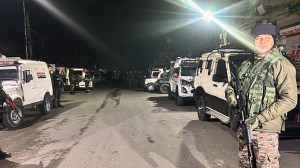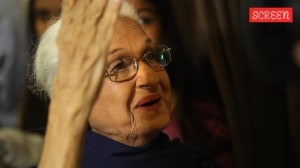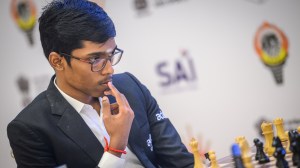Rules should be humane
If walls have votes, I've lost these elections. For thousands upon thousands of meters of wall space along the axial roads that criss-cross ...

If walls have votes, I’ve lost these elections. For thousands upon thousands of meters of wall space along the axial roads that criss-cross this constituency, the candidates of the major political combines have splayed their names and symbols in a glorious profusion of colours. Since each alliance comprises several parties, and each party has its particular set of colours, rustic Van Goghs and anonymous Anjolie Menons have been recruited in their hundreds to paint political graffiti wherever their creativity blossoms.
The artist has been no respector of prohibited places like government buildings and places of worship. Bridges and culverts, hospitals and dispensary walls, schools and community centres, temple walls and adheenams, indeed the very tar roads themselves, proclaim with pride that Mayiladuthurai has its M.F. Husains and Salvador Dalis.
Much of this, of course, is completely against the election law and the directives of Chief Election Commissioner M.S. Gill. The violations are so blatant, soflagrant, so aggressive and so self-confident that they do not require a T.N. Seshan disguised like some Sherlock Holmes to unearth the dark doings. The violations are proclaimed literally wherever you turn.
Yet, when I submitted a letter of protest to the election observer, I was asked if I could provide a few examples. The election observer could be forgiven, for she had only just arrived, a full three weeks after the election process started.
Till the arrival of the observer, it was the district administration which functioned as the eyes and ears of the Election Commission. Except that they did so with their arms and legs tied by the ruling party in the state.
Therefore, for three long weeks, not a single defaced government wall was undefaced. The administration confined itself to sending out polite circulars to the candidates listing their derelictions.
My chaps had defiled all of two government walls; the violations by rivals ran to scores and scores. Once the observers arrived and orderedde-defacement, candidates by and large confined themselves to applying a light coat of weak whitewash through which, right to the end, could be discerned the names and symbols of the indicted candidates.
Thus whatever publicity advantage is to be derived from painting the walls was derived unfettered by the candidates concerned till the last few days before the polls; and even as voters went to polls, I would guess that less than ten percent of what had been illegitimately captured has been restored to legitimacy.
Is this impotence the consequences of the end of the Seshan era? Far from it. Seshan was responsible for extending the writ of the Election Commission far beyond the limits to which the Commission could actually ensure compliance. If Seshan was nevertheless obeyed, it was because he had made arbitrariness into the law.
No candidate knew when Seshan would pounce on him or for what; fear of Seshanism rendered discretion the better part of valour. That is the principle on which Saddam Hussainrules Iraq. It is a somewhat inappropriate principle to be espoused by an Election Commission charged with running the largest democratic elections in the world.
What we need for better democracy is not the proliferation of rules, regulations, circulars and codes of conduct which characterised the Election Commission under Seshan, but simplification and rationalisation. While Gill has taken a giant step forward in modifying Seshan’s expense account format in the direction of simplification and rationalisation, the fact remains that one still requires the services of a qualified accountant to even begin to approach the norms set by the Election Commission.
It is ridiculous to expect that several thousands of candidates — many of whom live off agricultural incomes and, therefore, have never had to file even an income tax return — to comply with regulations that could confound even the Comptroller General. Compliance could be much more earnestly ensured by simply letting it be known to the candidates thatthe costs of visible publicity, such as wall paintings, are being computed by the administration and are expected to be reflected in the accounts; or being fined penalty points for each public wall defaced or each private wall captured through intimidation.
A process can be transparent only if it is simple and rational. The Election Commission, in tune with the rest of the British-built administration, assumes dishonesty and then attempts to counter dishonesty with a maze of checks and balances. It does not work.
On polling day we caught red-handed a rival booth agent distributing tiffin tokens valid for a nearby tea shop. We complained. Eventually, the returning officer concerned proudly informed me that he had closed down the tea shop. It did not occur to him that he was punishing the shopkeeper, not the candidate who had set up the scam. And when I asked the officer to put down in writing the action he had taken, he turned white as a sheet. For on the day after polling he reverts from being an officerof the Election Commission to an agent of the State Government and, therefore, of the ruling party. The lesson to be drawn is that when transparency is not ensured through simplicity, arbitrariness is raised to the role of arbiter.
What M.S. Gill and his colleagues need to do is call in a really first class management consultant. The consultant should be invited to do a thorough job of demolition on the mass of rules and regulations that have been spawned over nearly a century of progressively expanding democracy from Lord Minto to T.N. Seshan. Also, as no election commissioner has ever actually fought an election, the consultant should take a hard look at the hard realities on the ground, beginning with the candidates themselves.
The system should be tailored to what is possible to implement, not as at present, aimed at accommodating the requirements of a Ph.D thesis on ethics and elections, e.g. would the Election Commission please ask G.K. Moopanar how his photograph came to be published in thenewspapers as voting in Chennai when he is registered as a voter in my constituency of Mayiladuthurai (Kumbakonam assembly segment, Sundaraperumalkoil village, booth no 101, serial no 25)?


- 01
- 02
- 03
- 04
- 05





























